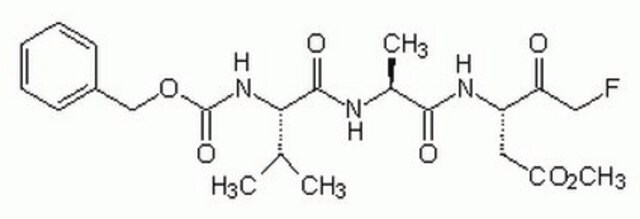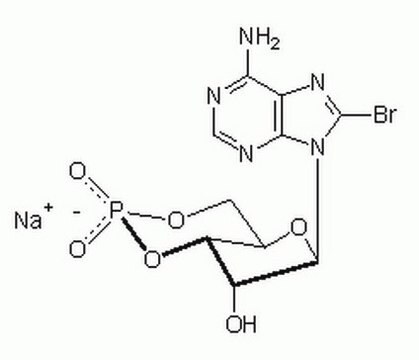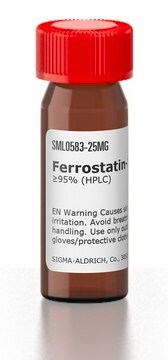197217
Bcl-xL BH44₋23, Human, Cell-Permeable
A cell-permeable peptide that prevents apoptotic cell death by directly binding to the voltage-dependent anion channel (VDAC) and blocking its activity.
Synonym(s):
Bcl-xL BH44₋23, Human, Cell-Permeable, HIV-TAT₄₈₋₅₇-β-Ala-Bcl-x L BH4₄₋₂₃, Ac-GRKKRRQRRR-βA-SNRELVVDFLSYKLSQKGYS-OH
Sign Into View Organizational & Contract Pricing
All Photos(1)
About This Item
Empirical Formula (Hill Notation):
C165H279N59O46
Molecular Weight:
3825.35
UNSPSC Code:
12352202
NACRES:
NA.77
Recommended Products
Quality Level
Assay
≥95% (HPLC)
form
lyophilized
manufacturer/tradename
Calbiochem®
storage condition
OK to freeze
desiccated (hygroscopic)
solubility
20% acetic acid: 5 mg/mL
DMSO: 5 mg/mL
shipped in
ambient
storage temp.
−20°C
General description
A cell-permeable peptide that prevents apoptotic cell death by directly binding to the voltage-dependent anion channel (VDAC) and blocking its activity. Leads to the inhibition of cytochrome c release and loss of mitochondrial membrane potential (ΔΨm). Contains the conserved N-terminal homology domain (BH4) of Bcl-xL (amino acids 4 - 23) that has been shown to be essential for inhibiting VDAC activity in liposomes and in isolated mitochondria. The BH4 domain is linked to a carrier peptide, a 10-amino acid HIV-TAT48-57 sequence with a β-alanine residue as a spacer for maximum flexibility. Following its uptake, it is mainly localized to the mitochondria.
A highly cell-permeable peptide that prevents apoptotic cell death by directly binding to the voltage-dependent anion channel (VDAC) and blocking its activity. Ultimately results in the inhibition of cytochrome c release and loss of mitochondrial membrane potential (ΔΨm). Contains the conserved N-terminal homology domain (BH4) of Bcl-xL (amino acids 4-23) that has been shown to be essential for inhibiting VDAC activity in liposomes and isolated mitochondria. The BH4 domain is linked to the carrier peptide, the 10-amino acid HIV-TAT48-57 sequence with a β-alanine residue as a spacer for maximum flexibility. Following its uptake, it is mainly localized in the mitochondria.
Biochem/physiol Actions
Cell permeable: yes
Primary Target
Voltage-dependent anion channel (VDAC)
Voltage-dependent anion channel (VDAC)
Product does not compete with ATP.
Reversible: yes
Packaging
Packaged under inert gas
Warning
Toxicity: Standard Handling (A)
Sequence
Ac-Gly-Arg-Lys-Lys-Arg-Arg-Gln-Arg-Arg-Arg-βAla-Ser-Asn-Arg-Glu-Leu-Val-Val-Asp-Phe-Leu-Ser-Tyr-Lys-Ser-Gln-Lys-Gly-Tyr-Ser-OH
Physical form
Supplied as a trifluoroacetate salt.
Reconstitution
Following reconstitution aliquot and freeze (-20°C). Stock solutions are stable for up to 3 months at -20°C.
Other Notes
Chen m., et al. 2002. J. Biol. Chem. 277, 29181.
Futaki, S., et al. 2001. J. Biol. Chem.276, 5836.
Shimizu, S., et al. 2000. Proc. Natl. Acad. Sci. USA97, 3100.
Futaki, S., et al. 2001. J. Biol. Chem.276, 5836.
Shimizu, S., et al. 2000. Proc. Natl. Acad. Sci. USA97, 3100.
Legal Information
CALBIOCHEM is a registered trademark of Merck KGaA, Darmstadt, Germany
Storage Class Code
11 - Combustible Solids
WGK
WGK 1
Flash Point(F)
Not applicable
Flash Point(C)
Not applicable
Certificates of Analysis (COA)
Search for Certificates of Analysis (COA) by entering the products Lot/Batch Number. Lot and Batch Numbers can be found on a product’s label following the words ‘Lot’ or ‘Batch’.
Already Own This Product?
Find documentation for the products that you have recently purchased in the Document Library.
Yi-Hsien Fang et al.
International journal of molecular sciences, 21(7) (2020-04-03)
Mature mammalian hearts possess very limited regenerative potential. The irreversible cardiomyocyte loss after heart injury can lead to heart failure and death. Pluripotent stem cells (PSCs) can differentiate into cardiomyocytes for cardiac repair, but there are obstacles to their clinical
Our team of scientists has experience in all areas of research including Life Science, Material Science, Chemical Synthesis, Chromatography, Analytical and many others.
Contact Technical Service








